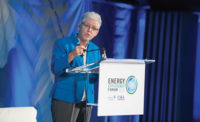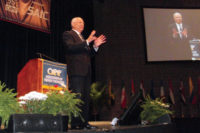WASHINGTON — Renewable energy and energy efficiency could bring about an “energy revolution,” said former President Bill Clinton in his keynote speech at the 2014 World Energy Engineering Congress, held at the Walter E. Washington Convention Center in Washington, District of Columbia. But, he said, it is being held back by a lack of financing.
“I have the feeling that finally we’re about to make a significant breakthrough” in the area of energy, said Clinton.
In 1997, when he signed the Kyoto Protocol — the international treaty that committed nations to reduce their greenhouse gas emissions — the Senate lined up 98-0 against the treaty before he could even send it to them for ratification, he noted.
It was believed that the U.S. could not reduce carbon emissions and have a successful economy, Clinton said. But, at that time, Sweden created a model that effectively cut the country’s emissions while growing its economy.
Recent discussion between the U.S. and China about reducing hydrofluorocarbons (HFCs) “is potentially a big step forward,” said Clinton. “Our countries could take one-half degree off the projected rise in global temperatures in this century.” It will work and it won’t hurt the economy, he asserted.
According to a study by Deutsche Bank, Germany netted 300,000 jobs due to its renewable energy transformation. On a sunny day last spring, it became the first significant industrial country to generate 74 percent of its energy from the sun and wind, Clinton said. “And this is in a country where the sun shines about as much as it does in London.”
The U.S., on the other hand, ranks first or second in the world in the capacity to generate energy from the sun and wind, said Clinton, referencing every evaluation he’s seen. “We’ve just scratched the surface here in the states.”
Clinton added: “Our capacity to affect energy efficiency in everything from retrofitting buildings to the most minute aspect of manufacturing is staggering.”
The Clinton Foundation, through its Clinton Climate Initiative, was involved in the retrofitting of the Empire State Building, which included retrofits of the HVAC, lighting, windows, and more. Johnson Controls Inc. carried out the building retrofit project and guaranteed energy savings of 38 percent. “Right now, they’re at about a 40 percent reduction,” said Clinton, noting the project will be paid off in less than five years.
Why aren’t we doing more retrofit projects? Not enough companies are willing to self-finance and there’s not enough financial assistance available, he said. “It’s all in the financing.” None of these projects is taking more than 6 ½ years to pay off. But the money isn’t there to do more.
“Financing is holding back the energy revolution.”
We need to figure out how to work through the infrastructure we have and how best to work fairly to implement these projects, said Clinton. One solution is to have utilities share the cost of the retrofit with customers. Another option is on-bill financing, giving consumers several options.
“All of the payoff on solar and wind energy is less than the cheapest coal-fired power plant,” commented Clinton. But, we still don’t have the funding that’s needed.
However, he is optimistic. “I think the economics of it will overcome all the denials.”
Understanding Utility Bills
Among the conference sessions, Robert Urban, project manager, Abraxas Energy Consulting, discussed “Understanding Utility Bills 101.” “Energy accounting is important because it tells you where facility costs have been and helps you manage future costs,” said Urban.
“Before you can track utility usage and costs, you have to understand utility bills. This is necessary before you can do an energy audit.”
Each utility charges in a manner that reflects its costs. They charge a higher rate as usage goes up and a lower rate as usage goes down.
To track costs and savings, Urban said you can use a “blended rate.” You establish your baseline kWh and actual kWh. Your savings equals baseline minus actual.
The blended rate is easy to use and apply, but it can give you misleading results.
You can also apply a “weighted average rate.” You get a full year or two years of bills and determine the average cost per kWh in summer and the average cost per kWh in winter.
You can look at applicable tariffs, total demand, and consumption charges. You can also break out on-peak consumption and off-peak consumption.
Energy Auditing
Andrew Brooks, C.E.M., director of West Coast operations, Association for Energy Affordability, presented “Energy Auditing Basics 101.”
Standards include ASHRAE’s auditing standards for commercial buildings, the Building Performance Institute Inc. (BPI) for residential, and Lawrence Berkeley National Laboratory (LBNL) for industrial.
Audit types include a vendor audit on specific equipment; a prescriptive program audit, which is specific for rebates; a targeted system audit for equipment that has failed; and a whole building audit.
First, a preliminary energy use analysis is done to evaluate the HVAC system, lighting, motors, and plug loads because of high energy costs, comfort issues, aging/failing equipment, opportunities for rebates/incentives, and green initiatives.
The pre-site visit procedures include a utility bill analysis, access to the building plans, and a pre-site visit interview. You need to coordinate what you need to do with building staff.
For the site visit, “take a camera and take as many pictures as you can,” said Brooks. After the visit, discuss your findings with building staff.
For your analysis, develop a list of energy conservation measures, such as installing variable frequency drives (VFDs), ventilation system balancing, temperature set point reductions, etc. Review the analysis and determine if the savings projections are within reason.
For scope negotiation/discussion, discuss what the client is able to do. The executive summary of your presentation “may be the only thing the customer ever reads,” Brooks said. Spend most of your time on this.
Implementing Energy Management
Randall Bohlman, technology advancement coordinator, facilities management, University of North Dakota, presented “The Art of Financing, Implementing, and Facilitating an Effective Energy Management and Sustainability Program.”
“To execute an energy-efficiency project, it takes money,” said Bohlman. Where do you get that money? His college has a utility budget and that budget is used to get bond funding. The energy savings achieved is used to repay the bonds.
For successful energy-efficiency projects, Bohlman said you need to develop a team approach. You need buy-in from all parties. “You need to establish a baseline for measurement and verification. You need to focus on the economic benefits, you need to evaluate the savings, and you need to demonstrate the success of each project.”
The school has an energy dashboard developed from its smart metering and from facilities management data, providing a tool for education and awareness.
Bohlman concluded by saying, if interested, users should opt for known technology, establish a firm baseline, make sure results are measurable, and make such economic successes public.
Achieving the Maximum
Maryanne McGowan, manager, strategy and implementation, Duke Energy, discussed “Maximizing Your Investment in Energy Efficiency.”
Enrollments are increasing and there are more mandates without funding. Why manage energy? The savings can be put back into the school budget, she said.
“Energy is a controllable expense,” said McGowan.
To carry out a project, you need to develop an energy savings master plan, she said. First, form an energy team. This should be a cross-functional team to ensure that everyone has ownership in the plan. Second, participate in a savings workshop. Clearly define goals and make it a continuous process of savings. Third, conduct a thorough on-site assessment. Fourth, follow up; track and ensure that you’re getting measurable results.
Energy plan components include an executive summary, a vision statement, goals and objectives, specific actions with staff assignments, and specific areas that goals should address. Be sure to look into incentive programs that are available, said McGowan. “Money is often left on the table.”
Energy Efficiency as an Investment
Matt Haakenstad, associate director, Navigant Consulting Inc., examined “Energy Efficiency as an Investment: The Value of Investing in Energy Efficiency at Your Facility.”
“It’s hard to beat energy efficiency as a resource,” he said.
Looking at it on a risk vs. return chart, it offers high return with low risk. It outdoes traditional investments.
Efficiency initiatives that can be undertaken include HVAC, lighting, water heating, refrigeration, and retrocommissioning.
“It is better to implement now and reap the savings rather than wait for technology improvements,” said Haakenstad.
Simple payback is always going to be calculated to determine whether an improvement is worthwhile. But you don’t want to use it as your only criteria, he said.
Haakenstad suggests supplementing it with net present value. It allows you to value the timing of the investment and your reward, and it shows you the cost of doing nothing. Another approach is internal rate of return.
“It seems like a no-brainer to invest in energy efficiency, but a lot of projects don’t get done,” Haakenstad noted. “Payback is the number one barrier. That’s a reason to look at other measures.”
Publication date: 12/8/2014
Want more HVAC industry news and information? Join The NEWS on Facebook, Twitter, and LinkedIn today!









